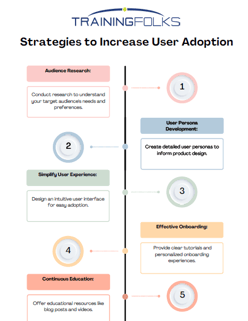Rolling out New Software?
Strategies to Increase User Adoption

In today's rapidly evolving digital landscape, user adoption is a critical factor for any new large-scale software implementation, such as Microsoft Dynamics 365 Training, Salesforce Training, SAP Training, ServiceNow Training, etc.
Whether it's a software application, a sales training software, a new platform, or an innovative tool, user adoption training directly impacts its viability, profitability, and long-term sustainability. In this blog, we will delve into the strategies that can help you master user adoption and ensure the success of your offerings.
Understanding User Adoption:
User adoption refers to the process of getting people to accept, use, and embrace a product or service. It goes beyond acquisition numbers and focuses on how effectively users integrate the software into their daily routines and workflows.
High user adoption rates indicate that your offering is meeting a genuine need and delivering value, while low adoption rates suggest that users are not finding your software compelling enough to continue using it.

Get our FREE Infographic Download
Strategies to Increase User Adoption
The Importance of User Adoption:
User adoption is not just about attracting initial users; it's about building a loyal and engaged base. For any business, the successful adoption of new technology, software, or systems by its employees is crucial. When your team fully embraces these tools, it enhances productivity, streamlines processes, and fosters innovation within your organization. User adoption ensures that the investments made in technology yield tangible benefits and contribute significantly to achieving business goals.
It's not just about having cutting-edge tools; such as the latest sales training software, it's about ensuring these tools are effectively integrated into the daily workflow of your employees. This integration leads to improved efficiency, better data utilization, and more informed decision-making. Moreover, high levels of user adoption are indicative of a strong organizational culture that values continuous learning and adaptation, key elements for staying competitive in today's dynamic business landscape.
Ensuring your employees are proficient and comfortable with new technologies is not just an operational necessity; it's a strategic imperative that drives long-term success and resilience.
Strategies to Increase User Adoption:
Successfully introducing new software or technology in an organization requires strategic planning and execution. Here are key strategies that leaders can employ to ensure effective user adoption:
User-Centric Design for Organizational Needs:
- Begin with a comprehensive understanding of the team's challenges, objectives, and preferences.
- Select or develop training that specifically addresses workplace needs, focusing on solving real problems and adding tangible value.
- Emphasize intuitive design to facilitate a smooth transition and reduce the learning curve for team members.
Streamlining the Upskilling Process:
- Develop an effective upskilling training process that guides employees through the initial stages of adopting the new system.
- Provide detailed tutorials and a personalized learning experience, ensuring every team member feels supported.
Promoting Continuous Education:
- Offer ongoing learning opportunities such as in-class and virtual workshops, eLearning, and access to knowledge bases to help the team master the new technology.
- Encourage proficiency in using advanced features, enhancing the overall experience and value derived from the tool.
Utilizing Data-Driven Insights:
- Analyze user data to gain insights into how the team interacts with the new technology and tailor further developments to meet their needs.
- Use this information to guide decision-making, ensuring updates or new features are relevant and beneficial.
Enhancing Customer Support and Engagement:
- Provide responsive support channels to address any team queries or issues promptly.
- Foster a community atmosphere through forums and discussions, valuing feedback and making every team member feel included in the technological evolution.
Incorporating Gamification and Incentives:
- Introduce elements of gamification and incentives to make the adoption process more engaging.
- Offer rewards for achieving certain milestones or utilizing new features to encourage exploration and comprehensive usage of the technology.
Focusing on Iterative Improvement:
- Continuously refine the software based on team feedback and changing needs.
- Build training for any release of updates and enhancements, ensuring they are well-received and meet the team's expectations.
Building Partnerships and Integrations:
- Explore partnerships and integrations with other tools that complement the new technology, enhancing its value and usability.
- Prioritize integrations with commonly used tools to streamline workflows and make the new system a seamless part of daily operations.
By adopting these strategies, leaders can facilitate the successful integration of new technologies into their organizations, ensuring these tools are effectively utilized and become integral to the team's workflow.
Measuring User Adoption:
It's essential to have a clear and quantifiable understanding of how well new technology or software is being adopted within the organization. Measuring user adoption involves tracking specific metrics that reflect the extent of usage and integration into daily workflows.
Key indicators include the rate of active usage, frequency of use, proficiency levels among team members, and the degree of reliance on the new system for routine tasks. Additionally, it’s important to assess qualitative factors, such as employee feedback, ease of use, and overall satisfaction with the technology. Regular surveys, user behavior analytics, and feedback sessions are effective tools for gathering this information.
This data not only provides insight into the current state of adoption but also helps identify areas needing further support or training. Ultimately, monitoring these metrics allows for ongoing adjustments and targeted strategies to ensure the new technology becomes a valued and effective tool within the organization.
Mastering user adoption is not just a one-time effort but an ongoing commitment to understanding and meeting the evolving needs of your users. By employing strategic approaches like user-centric design, streamlined onboarding, continuous education, and data-driven insights, you can significantly enhance the rate and quality of user adoption.
These efforts lead to creating a loyal, engaged user base and ensuring that your product or service is not only used but also valued within your organization. Measuring user adoption through metrics and regular feedback further guides the process, allowing for adjustments and improvements tailored to real user experiences.
Ultimately, the success of any new technology or software in today's digital landscape hinges on how well it is adopted by its users, making user adoption training a key to success.
